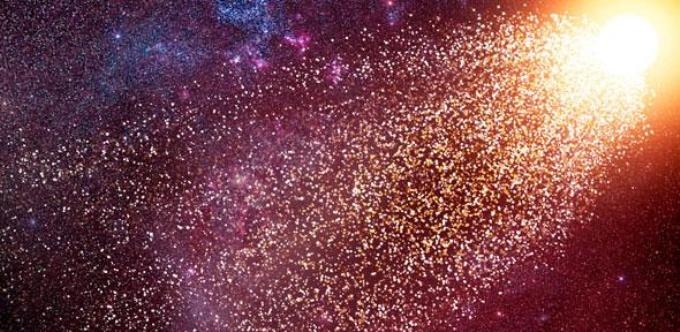Jul 5 2017
A team of Astronomers have demonstrated that the fastest-moving stars in the galaxy are actually runaways from a much smaller galaxy in orbit around our own. These stars travel so fast that they are capable of escaping the Milky Way.
 This is an Artist's impression of runaway stars. CREDIT: Amanda Smith
This is an Artist's impression of runaway stars. CREDIT: Amanda Smith
University of Cambridge Researchers used data from the Sloan Digital Sky Survey and computer simulations in order to show that these stellar sprinters initially developed in the Large Magellanic Cloud (LMC), which refers to a dwarf galaxy in orbit around the Milky Way.
Hypervelocity stars, referring to these fast-moving stars, were capable of escaping their original home when the explosion of a single star in a binary system resulted in the other to fly off with such speed that it actually escaped the gravity of the LMC and then got absorbed into the Milky Way. The findings have been published in the Monthly Notices of the Royal Astronomical Society, and will be presented at the National Astronomy Meeting in Hull on 5th July, 2017.
Initially, Astronomers assumed that the hypervelocity stars, which are big blue stars, may have been barred from the Milky Way’s center by a supermassive black hole. Other scenarios dealing with chaotic star clusters or disintegration of dwarf galaxies can also be considered to account for the speeds of these stars, however, all these three mechanisms have not succeeded in explaining why they are just present in a specific part of the sky.
Approximately 20 hypervelocity stars have been observed to date, by and large in the northern hemisphere, despite the possibility that many more stars could be observed in the southern hemisphere.
Earlier explanations for the origin of hypervelocity stars did not satisfy me. The hypervelocity stars are mostly found in the Leo and Sextans constellations – we wondered why that is the case.
Douglas Boubert, a PhD Student, Cambridge’s Institute of Astronomy and the Paper’s Lead Author
The fact that the hypervelocity stars are runaways from a binary system is considered to be an alternative explanation to their origin. In binary star systems, the extreme closeness of the two stars allows them to orbit one another in a rapid manner. The explosion of one star as a supernova, results in breaking up the binary and the remaining star flies off at the very same speed in which it was orbiting. The escaping star is called a runaway. Runaway stars that originate in the Milky Way are not adequately fast to be hypervelocity since blue stars are not capable of orbiting close enough without the two stars merging. However, a fast-moving galaxy is capable of giving rise to these speedy stars.
The LMC is considered to be the fastest and largest of the dozens of dwarf galaxies in orbit around the Milky Way. The fastest runaways originated in this dwarf galaxy can effortlessly escape its gravity since the LMC has only 10% of the mass of the Milky Way. The LMC flies around the Milky Way at 400 km per second and, just like a bullet fired from a moving train, the speed of these runaway stars refer to the velocity they were ejected at and also to the velocity of the LMC. This is considered to be enough for them to be considered as hypervelocity stars,
These stars have just jumped from an express train – no wonder they’re fast. This also explains their position in the sky, because the fastest runaways are ejected along the orbit of the LMC towards the constellations of Leo and Sextans.
Rob Izzard, Co-Author and a Rutherford Fellow at the Institute of Astronomy
The Researchers modeled how hypervelocity stars could escape the LMC and land in the Milky Way by using a combination of data from the Sloan Digital Sky Survey and computer simulations. They simulated the birth and death of stars in the LMC over the past two billion years, and then made a note of every runaway star. After being kicked out of the LMC, the orbit of the runaway stars was then followed in a second simulation that comprised of the gravity of the LMC and the Milky Way. With these simulations, the Researchers were able to predict where on the sky one can expect to locate runaway stars from the LMC.
“We are the first to simulate the ejection of runaway stars from the LMC – we predict that there are 10,000 runaways spread across the sky,” said Boubert. Half of the simulated stars, which escape the LMC are considered to be adequately fast such that they can escape the gravity of the Milky Way, enabling them to be hypervelocity stars. If the earlier known hypervelocity stars are runaway stars, it will be possible to explain their location in the sky.
Gigantic blue stars end their lives by collapsing to a black hole or neutron star after hundreds of millions of years, and runaway stars are no different. After being kicked out of the LMC, most of the runaway stars in the simulation died ‘in flight’. The black holes and neutron stars that are left behind only continue on their way and so, together with the 10,000 runaway stars. The Researchers also predict a million runaway neutron stars and black holes flying via the Milky Way.
We’ll know soon enough whether we’re right. The European Space Agency’s Gaia satellite will report data on billions of stars next year, and there should be a trail of hypervelocity stars across the sky between the Leo and Sextans constellations in the North and the LMC in the South.
Douglas Boubert, a PhD Student, Cambridge’s Institute of Astronomy and the Paper’s Lead Author